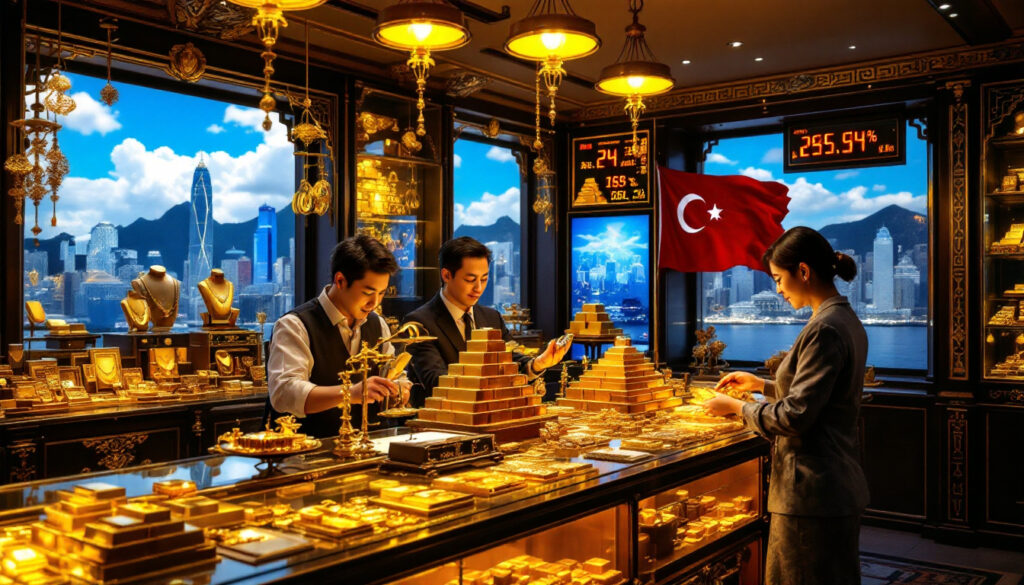What’s Happening in Hong Kong’s Gold Market?
The precious metals market in Hong Kong has reached unprecedented heights, with gold prices shattering previous records and transforming the traditional dynamics between buyers and sellers. Local gold shops in Hong Kong, once primarily focused on selling gold jewelry and bullion to customers, are now eagerly buying back gold at premium rates—creating a unique opportunity for those looking to liquidate their gold assets.
Record-Breaking Gold Prices in Hong Kong
Hong Kong’s gold market has witnessed extraordinary growth, with local gold prices reaching an all-time high of HK$30,930 per tael troy (equivalent to US$3,991 for 37.429 grams) in recent trading. The market closed at HK$30,710 on April 17, 2025, after breaking through the psychologically significant HK$30,000 threshold that had long been viewed as a major resistance level by market analysts.
This meteoric rise represents a 27% increase in gold prices during 2025 alone, following an already impressive 26% surge throughout 2024. The consecutive years of strong growth have created what industry experts describe as an “extreme euphoria” phase in the market, with both institutional and retail investors rushing to increase their exposure to the precious metal.
Global Gold Market Context
The exceptional performance of gold in Hong Kong reflects broader international trends, with the global benchmark gold price hitting a record high of US$3,357.60 per troy ounce (31.10 grams). This worldwide rally has been primarily driven by increased demand for safe‐haven assets amid escalating global tensions.
Brian Fung, CEO of the Hong Kong Gold Exchange, explains: “The intensifying trade war has triggered unprecedented market volatility, causing investors to question the stability of both stock markets and traditional currencies. As a result, capital is flowing toward gold as a trusted store of value during these uncertain times.”
Central banks worldwide have also been aggressively increasing their gold reserves, adding further demand pressure to an already tight market. This institutional buying, combined with retail investor interest, has created a perfect storm for gold price analysis and appreciation.
Why Are Hong Kong Gold Shops Becoming Buyers?
Reversed Business Strategy
One of the most fascinating developments in Hong Kong’s gold market is the strategic shift among traditional gold shops. These establishments, which historically focused primarily on selling gold jewelry and investment products to customers, have pivoted dramatically to actively purchasing gold from the public.
According to industry surveys, approximately 60% of Hong Kong’s gold retailers now prioritize buyback operations over retail sales—a complete reversal from their traditional business model. This transformation reflects the shops’ efforts to capitalize on rising prices by acquiring gold assets that can later be sold to institutional buyers or refined and resold as new products.
“Gold shops are essentially acting as middlemen in this market,” notes Fung. “They’re leveraging rising prices to accumulate inventory, often securing 2-5% margins on these buyback transactions before selling to larger institutional players or refineries.”
Economic Factors Driving the Shift
This strategic pivot by Hong Kong’s gold retailers is directly linked to broader economic pressures. The ongoing trade tensions have created persistent market uncertainty, pushing institutional investors to increase their precious metals allocations as a hedge against volatility.
Central bank gold reserves grew approximately 15% globally in 2024, reflecting a worldwide trend of diversifying away from traditional reserve currencies. This institutional demand has created profitable opportunities for gold shops that can acquire and aggregate smaller gold holdings from individual sellers.
The unique position of Hong Kong—with its USD-HKD currency peg but close proximity to mainland China—creates additional pricing agility for local gold traders. They can capitalize on cross-border arbitrage opportunities while maintaining the stability provided by the currency peg, making buyback operations particularly attractive in the current market environment.
Where to Sell Gold in Hong Kong
Popular Gold Shopping Districts
Tsim Sha Tsui stands out as Hong Kong’s premier gold trading hub, hosting over 70 licensed gold traders within its busy commercial district. This concentration of buyers creates a competitive environment that typically benefits sellers through better pricing and more flexible transaction terms.
Other notable areas for gold transactions include the traditional jewelry districts in Central, Causeway Bay, and Mong Kok. These established gold exchange locations often feature multi-generational family businesses with deep connections to Hong Kong’s gold trading history.
The most advantageous selling opportunities typically come from shops that maintain active operations on both the buying and selling sides, as these establishments have the infrastructure and liquidity to offer competitive rates. Prestigious shops like Chow Tai Fook maintain a strong reputation for fair pricing and transparent transactions.
What to Expect When Selling Gold
When selling gold in Hong Kong, pricing is transparently tied to daily market rates, with shops typically offering between 85-98% of the spot price depending on the purity and form of the gold. Pure 24K gold items generally command around 98% of the spot price, while 18K gold items might fetch closer to 85% due to refining costs.
Documentation requirements increase substantially for larger transactions. As Fung notes, “Regulatory scrutiny and paperwork requirements increase significantly for transactions exceeding HK$120,000.” Sellers should be prepared to present their HKID, original purchase receipts when available, and potentially third-party appraisal certificates for unusual or high-value items.
The most sought-after gold items in the current market include standard gold bars, Chinese gold jewelry (particularly pieces with minimal craftsmanship premiums), and gold coins from recognized international mints. Items with higher purity will generally secure better rates as they require less refining.
How to Get the Best Price for Your Gold in Hong Kong
Timing Your Sale
Gold prices in Hong Kong have demonstrated significant intraday volatility, with price fluctuations averaging 1.8% during Q1 2025. This volatility creates opportunities for strategic selling, particularly during morning trading hours between 9-11 AM, which have historically yielded approximately 0.3% premium over afternoon rates.
Monitoring both local gold exchange rates and international benchmark prices can help identify optimal selling windows. Fung advises sellers to “watch for COMEX-LBMA arbitrage windows, which can temporarily create more favorable local pricing.”
Understanding gold market trends and psychology is equally important when timing gold sales. The current “extreme euphoria” phase typically precedes correction periods, suggesting that sellers might benefit from liquidating before potential market normalization. However, the unprecedented nature of current geopolitical tensions makes timing predictions particularly challenging.
Comparing Shop Offers
Price variations between different retailers can be substantial, with spreads of up to 3% between competing shops for identical gold items. This variance makes comparison shopping worthwhile, especially for larger transactions.
Commission structures and handling fees differ significantly across establishments. Chain retailers typically offer standardized rates with lower negotiation flexibility, while independent dealers may charge lower base commissions but expect more haggling.
Reputation factors should not be overlooked when selecting a buyer for your gold. Established retailers with physical locations and longstanding market presence provide security that may justify slightly lower offered prices compared to less established operations.
Some shops, like Luk Fook Holdings, now offer innovative 24-hour price-lock services that allow sellers to secure a specific rate even if they cannot complete the transaction immediately—a valuable feature in a volatile market.
Expert Insights on Hong Kong’s Gold Market
Analysis from Industry Leaders
According to Brian Fung, the current gold price rally is directly linked to US tariff policies: “The uncertainty created by escalating trade tensions has fundamentally altered investor risk perception, driving unprecedented capital flows into precious metals.”
Industry analysts point to the strong negative correlation between gold prices and the USD/CNH exchange rate (r = -0.79), highlighting how currency market volatility directly impacts gold pricing. This relationship suggests that any stabilization in currency markets could potentially dampen gold’s appeal.
Fung predicts a potential 18-22% price correction if US-China tariffs are lifted or significantly reduced, noting that “much of gold’s current premium is directly attributable to trade-related uncertainty rather than fundamental supply-demand dynamics.”
Long-term Market Outlook
The sustainability of current price levels remains a subject of intense debate among market experts. While the immediate price trajectory has been strongly positive, historical patterns suggest that periods of extreme price appreciation are typically followed by consolidation phases.
Factors that could reverse the current buying trend include resolution of trade tensions, significant interest rate increases by major central banks, or substantial profit-taking by institutional investors who have accumulated large positions during the rally.
In historical context, the current market conditions share similarities with previous gold bull markets, particularly the 2010-2011 period, though the present rally has been more sustained and less volatile on a relative basis.
Potential trade resolution remains the most significant risk factor for gold prices, with Fung’s analysis suggesting that any substantive agreement between major economies could trigger a rapid reallocation of capital away from gold’s role as a hedge against economic uncertainty.
FAQs About Selling Gold in Hong Kong
What documentation do I need to sell gold in Hong Kong?
For standard transactions, Hong Kong residents should bring their HKID card, while non-residents will need to present passport identification. For transactions exceeding HK$120,000, additional documentation is typically required under Hong Kong’s Anti-Money Laundering Ordinance.
Proof of ownership, while not always mandatory, can facilitate the transaction and potentially lead to better pricing. Original receipts, certificates of authenticity, or appraisal documents are all valuable supporting materials.
Tax implications vary depending on whether the seller is a resident or non-resident, with different reporting thresholds applying to each category. Residents generally face fewer reporting requirements for standard gold sales, while non-residents may need to comply with additional documentation standards.
How is gold priced in Hong Kong compared to international markets?
Hong Kong’s gold pricing formulas closely align with the London Bullion Market, though local rates typically include a small premium or discount reflecting regional supply-demand dynamics. This premium/discount structure fluctuates based on local market conditions.
Currency considerations play a significant role in pricing, with the Hong Kong dollar’s peg to the US dollar creating a stable pricing environment compared to markets with floating exchange rates. This stability makes Hong Kong an attractive gold trading hub for the broader Asian region.
Price updates occur with high frequency throughout trading hours, with most shops refreshing their rates at least hourly during periods of heightened volatility. Some premium establishments now offer real-time pricing that adjusts continuously based on international market movements.
What types of gold items fetch the highest prices?
Purity is the primary determinant of value, with 24K (99.9% pure) gold commanding the highest percentage of spot price—typically around 98% in the current market. Lower karatage items (22K, 18K, 14K) receive progressively lower percentages of the spot rate due to refining costs.
Weight is the second most important factor, with heavier items generally securing better rates per gram due to processing efficiencies. Shops typically use certified scales and weigh items in front of customers to ensure transparency.
Standard bullion products from recognized mints and manufacturers generally command higher prices than custom jewelry, as their purity and weight are standardized and easily verified. However, certain collectible items with historical or artistic significance may command premiums above their intrinsic gold value.
Condition assessment focuses primarily on identifying any non-gold components that would affect the overall purity, rather than aesthetic considerations. Damaged gold items typically receive the same price as intact pieces of equivalent weight and purity. For those looking to maximize their returns, understanding various gold ETFs strategies can provide additional investment options beyond physical gold.
Disclaimer: This article contains market analysis and predictions based on current trends and expert opinions. Gold prices are inherently volatile and subject to rapid changes based on economic and geopolitical factors. Readers should conduct their own research and potentially consult with financial advisors before making significant investment or divestment decisions regarding precious metals.
Want to Discover the Next Major Mining Opportunity?
Stay ahead of the market with Discovery Alert’s proprietary Discovery IQ model that provides real-time notifications of significant ASX mineral discoveries, transforming complex data into actionable investment insights. Explore historic examples of exceptional investment returns at the Discovery Alert discoveries page and position yourself to capitalise on the next major mineral discovery.




